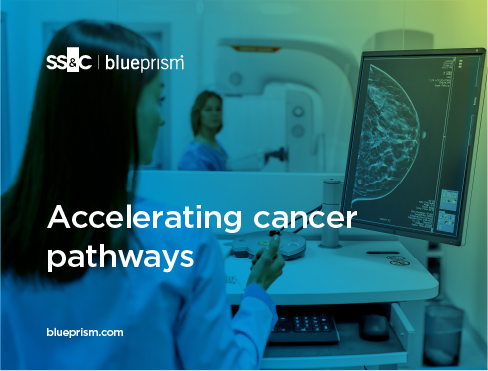Blog
7 Automation Tech Trends in Healthcare
Contact Us

Increased demand on healthcare providers requires streamlined operations, personalized patient care and data-driven insights to augment clinical work. Through the power of digital technologies – artificial intelligence (AI), machine learning (ML), business process management (BPM) and robotic process automation (RPA) – intelligent automation (IA) can transform healthcare services, making providers more efficient, patient-centric and accurate.
We know the importance of keeping healthcare human. That’s why we’re enabling more healthcare organizations to save time from manual tasks and help their clinicians get more time with their patients.

As a healthcare provider, you want to ensure a smoother, more personalized patient experience, and that’s possible through IA digital healthcare solutions, which ensure faster onboarding, more patient-clinician time, shorter wait times and faster time-to-results.

Healthcare automation is transforming healthcare organizations, motivated by patient preference to give them more time with clinicians and less time waiting in queues. Automation gives administrative staff more interesting and impactful work, and augments healthcare professionals’ work with access to accurate, timely patient information to aid decision-making.

SS&C Blue Prism is at the leading edge of healthcare transformation, going beyond implementing RPA to provide intelligent automation in healthcare that enables organizations to meet their strategic business priorities, support their people and create exceptional patient experiences. By supporting your teams, bridging system gaps and assisting patients, our digital workers are welcoming a new era of patient experience with scalability, flexibility and security.
Improved accuracy
Free staff for more valuable work and streamline administrative tasks, which are time-consuming and error-prone. Standardize processes with a robust operating model. Respond to new challenges precisely to reduce the risk of non-compliance.
Financial sustainability
Lower operating costs, increase productivity and transform revenue cycle management. When healthcare providers automate repetitive tasks, they can reduce labor costs and allocate resources more efficiently. Increase the speed and quality of care.
More integrated care
Access patient data in a centralized platform to aid decision-making. Get real-time decision support with patient record analysis, treatment suggestions and alerts about potential issues. Enable faster diagnoses and so clinicians can focus on critical care first.
Enhanced patient care
Innovate patient engagement models with patients scheduling their own appointments and clinical staff having fewer backlogs. Give patients access to their medical records and test results through a secure online portal – reducing calls and visits.
Better compliance
Intelligent automation keeps comprehensive audit trails of all actions performed, including who performed them and when, and inputs them into a log that flags unauthorized or inappropriate access. Enforce strict access controls to protect data privacy laws.
Faster diagnostic results
Seamlessly integrate between systems, allowing for real-time data analytics, updates and access to medical results. Auto-fill data fields to reduce data entry errors and time delays. Give patients critical results sooner with an IA dashboard.

Learn how to significantly reduce time between diagnosis and treatment, and how organizations like the NHS are implementing intelligent automation to accelerate cancer pathways.
Implementing RPA or IA into healthcare processes can revolutionize care. The healthcare sector is full of automation use cases to improve manual and duplicated processes and, crucially, free up healthcare professionals’ time to care for their patients.
With growing patient numbers, healthcare providers want to improve the patient experience, and that can be done with faster onboarding, more patient-clinician time, shorter wait times and faster time-to-results. Whether this means enabling a digital front door to services, offering more tailored correspondents or just getting more out of their interactions with clinicians, patients want information at their fingertips and services on demand.
Give patients the freedom to initiate their care in whatever way suits them best. From self-service portals, automated appointment scheduling and appointment reminders, self-check-in kiosks and so on, digital workers are helping patients find more convenient ways to access care that reduces the time they spend filling out paperwork and sitting in the waiting room.
Develop an online portal or app where patients can self-schedule appointments and see doctors’ availability.
Regardless of the patient care setting, it’s important that patient engagement looks and feels the same across the board. By standardizing practices across your entire clinical system, you can ensure consistent experiences while remaining personalized, so patients don’t ever feel like just a number on a waiting list. Automate referral management, claims management, diagnostics and more.
Automatically analyze patient data, medical history and referral criteria to provide decision support to healthcare providers. This includes suggesting specialists or facilities based on the patient's needs or insurance coverage, where applicable.
Facilitate appointment scheduling and coordination between referring providers and specialists' offices. This includes sending appointment reminders, coordinating scheduling preferences and managing cancellations/rescheduling requests efficiently.
IA seamlessly integrates between systems, allowing for real-time updates and access to medical results. Digital workers can auto-fill data fields to reduce the number of data entry errors and they work quickly, meaning crucial data is logged sooner.
Empower your contact center teams to better serve patients by automating simple inquiries and creating a single source of truth for patient data established by the user. By doing this, agents are free from time-consuming tasks and now have time to focus on patient needs, and patients spend less time on the phone.
Patients can interact with natural language bots to schedule appointments, check availability and receive confirmation via email or SMS.
Generate and send automated appointment reminders via SMS, email or automated voice calls to patients, reducing the number of missed appointments.
IA can engage patients throughout the referral process by providing educational resources, appointment reminders and guidance on next steps. This empowers patients to actively participate in their care journey and ensures better adherence to referral recommendations.
IA can optimize healthcare prior authorization workflows, reduce claim denials from health insurers, relieve common patient access challenges, speed up patient registration and automate critical revenue cycle tasks.
Quickly verify patient eligibility and insurance coverage for specific medical services or treatments. By accessing insurance databases and patient records, IA can determine whether prior authorization is required and streamline the initial screening process.
Automated prior authorization platforms can facilitate real-time submission of authorization requests to insurance companies and track the status of pending requests. This includes monitoring for approvals, denials or requests for additional information.
Streamline communication between healthcare providers and insurance companies. This includes electronic information exchanges, automated notifications for status updates and electronic signatures for authorization requests, reducing reliance on manual paperwork and phone calls.
Digital workers can capture key insurance claims data and input it into systems in real-time. Where claims are submitted in a structured electronic format, they’re sent to a scanning mechanism while paper-based claims are digitized. Then, digital workers can automatically sift through payer checks and balances to determine whether a prescribed medication is medically necessary and appropriate, trigger any missing data and pull the contracted medication price.
Automated systems can extract relevant information from claim forms, medical records and other sources, perform eligibility checks and process claims according to predefined rules and policies. This reduces manual effort, accelerates claim turnaround times and minimizes errors.
IA tools analyze large volumes of claims data to identify patterns, anomalies and suspicious activities indicative of fraudulent behavior. Digital workers can flag potentially fraudulent claims for further investigation, helping mitigate financial losses.
By bringing IA into the lab, life sciences organizations can limit manual errors while speeding up drug development from lab to market. Digital workers take advantage of large data sets and advanced software to do things a team of scientists might take days to complete. IA augments drug discovery, preclinical research and clinical trials.
Accelerate the drug discovery process with machine learning (ML) algorithms analyzing vast datasets and identifying potential drug candidates. Automated systems can predict molecular structures, assess drug-target interactions and prioritize compounds for further testing based on efficacy and safety profiles.
IA can streamline preclinical and clinical trial processes and optimize study design, patient recruitment and data analysis to expedite new therapy development.
Automate inventory management, procurement and distribution processes. IA can forecast demand, track inventory levels and coordinate logistics operations.
Revenue cycle automation (RCM) gives healthcare providers access to a software platform that automates any management processes, interacting with line-of-business applications to improve communication and streamline claims submissions, back-office functions, billing and reimbursements and hospital record updates.
Automate patient data entry to reduce errors. IA can collect patient details accurately and input them into the system.
IA can perform real-time eligibility checks to verify insurance coverage – improving revenue capture and reducing claims denials.
IA can generate accurate claims based on standardized code sets and payer requirements, reducing errors and accelerating claim submission timelines.
IA can analyze denial codes, claims data and payer feedback to prioritize and escalate appeals effectively.
IA can generate and distribute statements, invoices and payment reminders and can customize billing communications based on patient preferences, payment history and outstanding balances.
We can save 200,000 hours per day through gen AI and automation streamlining patient clinical records. Gen AI summarizes a patient’s session, and that allows the GP or clinician to spend more time with the patient."
Automation architect, NHS Dorset.
“We see that digital health and digital technology has an impact on both the outcome we are able to deliver for a patient and an impact on cost of care delivery.”
CEO and head of digital health, Mercy Radiology
The biggest challenge to the NHS at the moment is the workforce. RPA is something that can positively contribute to the delivery of the tracking on our cancer pathways in a way that doesn't involve recruitment. So, I would encourage other cancer alliances or cancer service providers to consider using automation to support the delivery of the cancer pathways in their patch.”
Program manager, Northern Cancer Alliance
We had a huge problem around high-volume referrals for crucial appointments, impacting both safety and patient experience. Working with digital innovators and clinicians to build algorithms, we used automation technologies to read referrals, allocate appointments, update maternity records and notify pregnant people of their appointments. Automation has been a revelation.”
Director of maternity services and midwifery, Portsmouth Hospitals, University NHS Trust
If your network blocks YouTube, you may not be able to view the video on this page. In this case, please use another device. Pressing play on the video will set third-party YouTube cookies. Please read our Cookies Policy for more information.